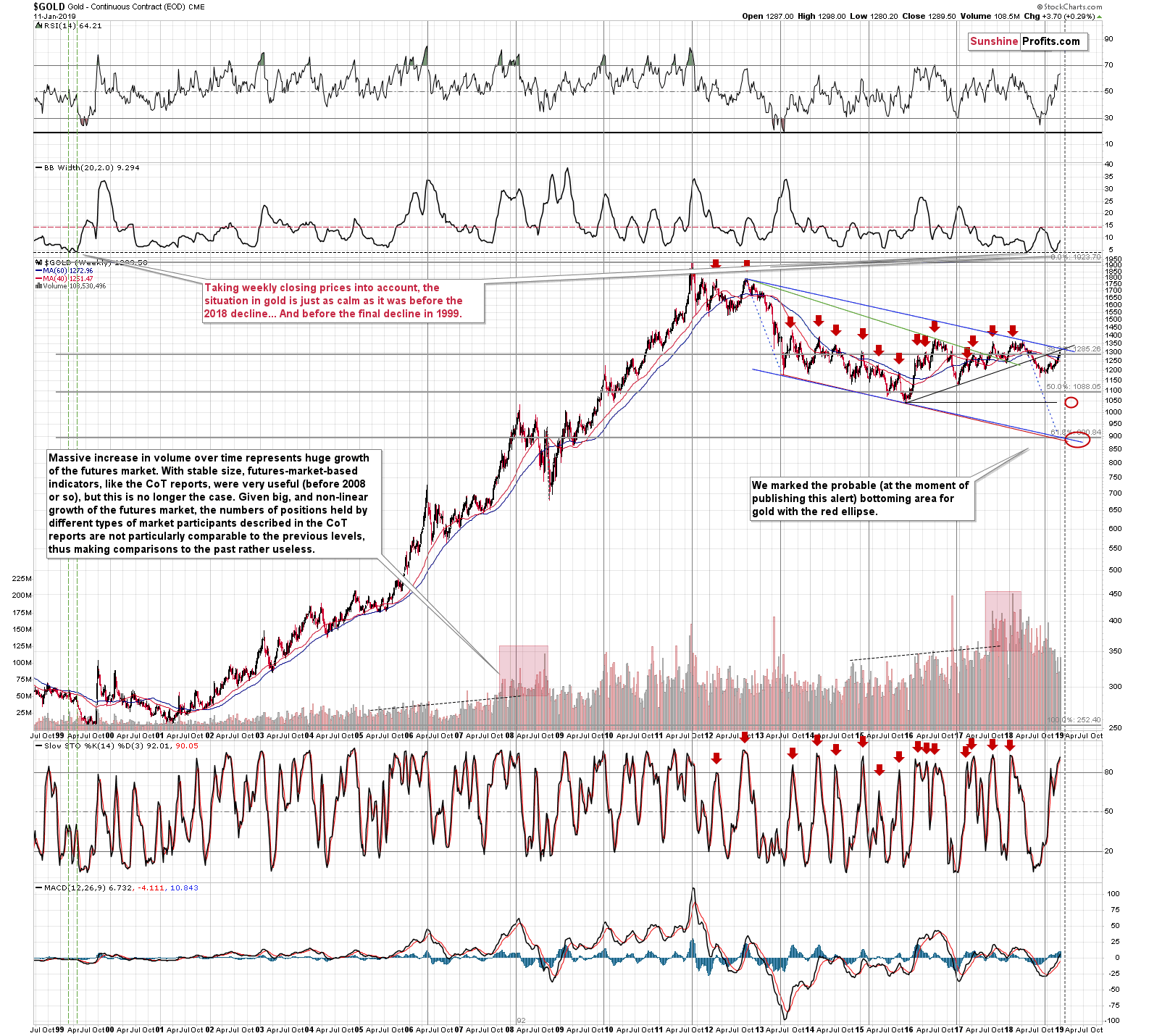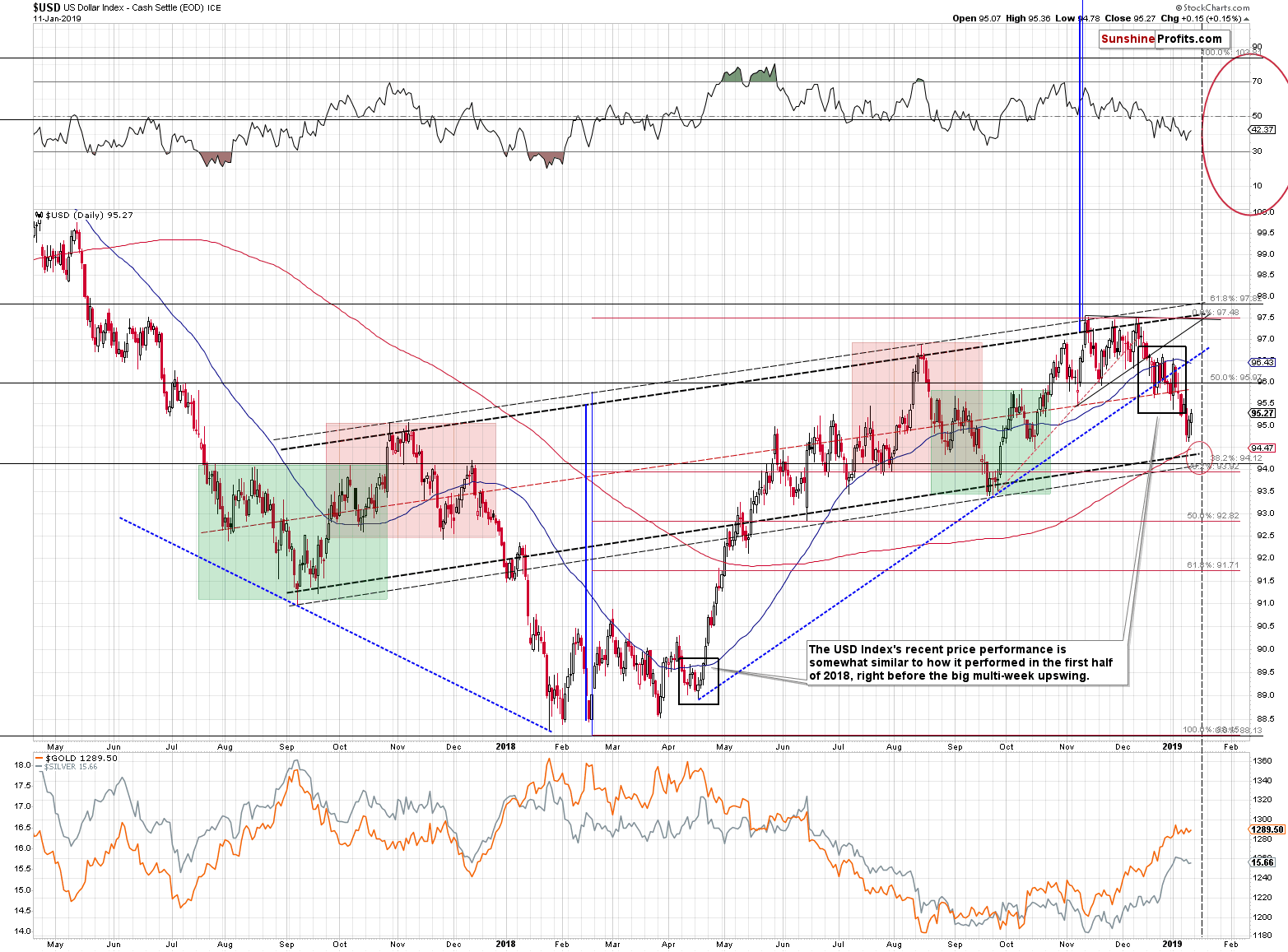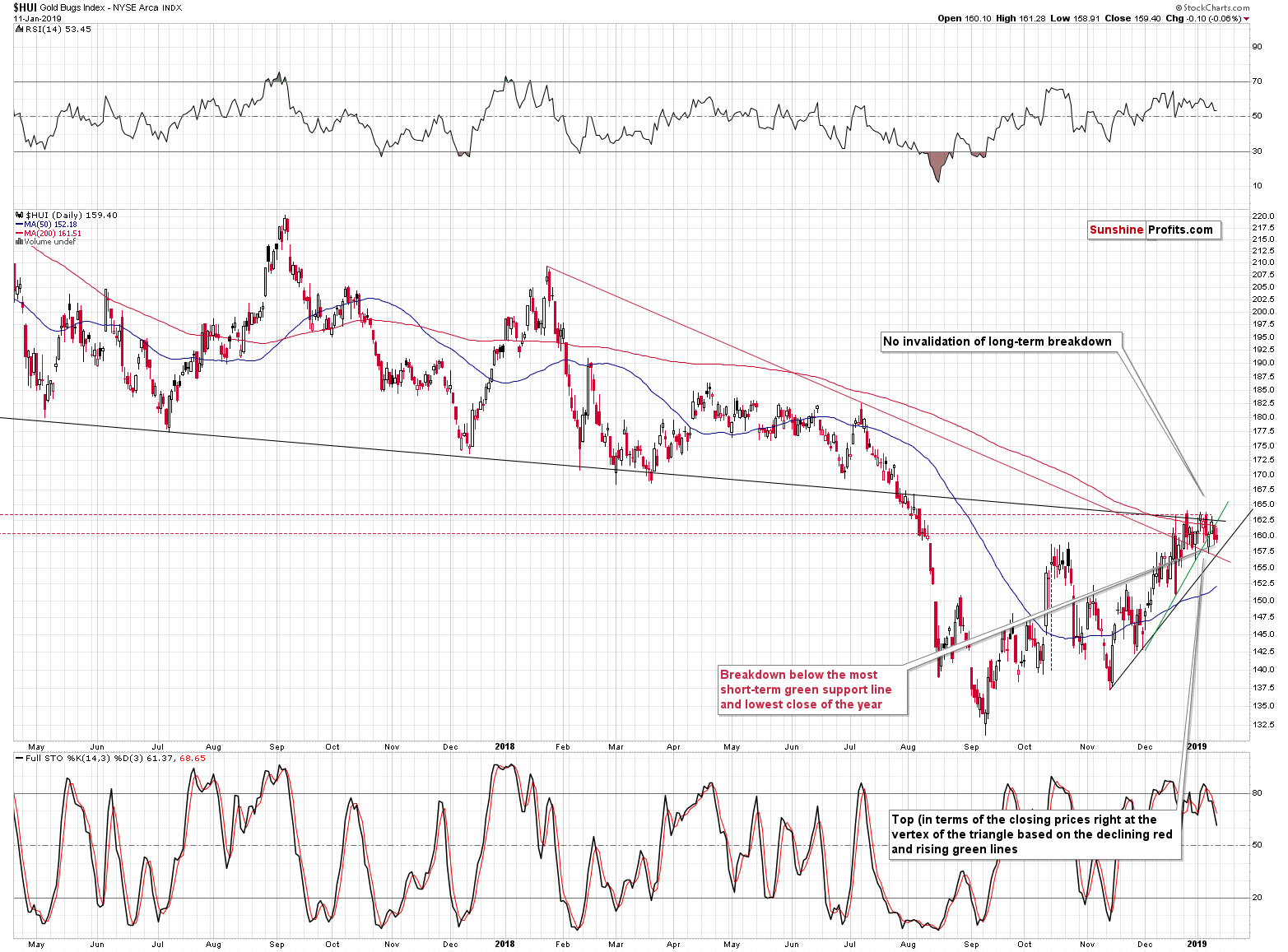Briefly: in our opinion, full (250% of the regular size of the position) speculative short positions in gold, silver and mining stocks are justified from the risk/reward perspective at the moment of publishing this Alert.
The prices of gold and silver and the values of mining stocks increased in the past few months despite the bearish long-term signals and the analogy to 2013. At some point, when something doesn’t work, it’s time to drop it and move to things that do work. The 2013 – now link in gold doesn’t appear to be working anymore as gold deviated from it too much. If we take this factor out of the long-term picture, what will remain? What do the up-to-date signals suggest for the prices of metals and mining stocks?
In short, the above changes much less than it seems to be the case at the first sight. The 2013 – now analogy in gold was only one of the long-term factors that made the long-term outlook bearish. For instance, the analogy to 2008 in silver remains in place. Just because the situation in gold is no longer very similar to what happened in 2013, it doesn’t mean that we saw a bullish signal – we simply have one bearish signal less. Does this make the number of bearish signals small enough to change the medium-term outlook? Absolutely not. The 2013-now link in gold may be gone, but new long-term signals emerged in the meantime, making the overall outlook just as bearish. For instance, gold’s link with the stock market and with its volatility and the new medium-term sell signal from the silver to gold ratio that we discussed on Thursday.
So, if the outlook didn’t change, then why is gold not below $1,000 yet?
The outlook didn’t change, but it doesn’t imply the absence of real-world shockers and news that will temporarily move the price. If there’s World War 3, gold would soar regardless of what any chart was suggesting. If there’s a trade war, there will also be a reaction, although not as dramatic. If there’s a series of angry tweets from Trump, market may also react. Does it make the chart analysis useless? Absolutely not. In the majority of cases, the market will move where it’s likely to move, usually once the dust settles after the price-changing news are announced. This means a delay in the expected action and this is most likely what we saw in case of the PMs and miners. The decline didn’t end – it was delayed. As long as the outlook remains bearish, the price is likely to fall – after all that’s what the work outlook means.
If we were able to control the news and the developments, we would “make them” wait until the price reaches the likely price levels. But, of course, this is not possible, and we can only take what the world and the market gives us and analyze it in order to check if the outlook changed or not. While any single piece of news doesn’t depend on us, adjusting the outlook does. And the same goes with the changes in positions.
Consequently, the direct reply to the above question is that gold is not below $1,000 yet because the decline was delayed based on the factors that don’t depend on us. It remains to be the likely outcome anyway. Before moving on to long-term charts, we would like to discuss how these delays can be handled.
Handling the Delays in Big Price Moves
There are generally two ways to handle the delays.
The first way is to be patient and wait for the price to move in tune with its outlook. In this case it’s particularly important to keep re-evaluating the outlook each day to detect the moment when the outlook would change (this may mean changing the target prices and stop-loss levels along the way). This way maximizes the chance of not missing out on the move that’s likely to take place based on the outlook. The price for that is the delay itself, which makes it very difficult for more short-term oriented traders to take advantage of the situation. This also means the need to accept temporarily lower profits (or capital in general) with the goal of making much more when the move finally materializes.
The second way is to become very short-term oriented and focus on more short-term trades (even intraday moves) and thus to make the delays rather irrelevant. The delay in the bigger move doesn’t matter if you’re not aiming to catch it, but instead to profit on many smaller moves. This approach means more regular profits and the inherent mechanism not to hold to a losing trade for too long (narrow stop-loss and profit-take mean that the position would likely be closed shortly after it’s opened). The price for the above is much lower chance of profiting on the big move that was likely based on the outlook.
Both approaches have their merits and the first one is likely to be more profitable in case of strong moves in a given direction, whereas the second one is likely to be more profitable during consolidations. But profitability is not all there is – the latter strategy may simply be more pleasant to follow for the more short-term oriented traders and for those, who have particularly strong aversion to temporary losses.
In case of the current situation in the precious metals market, we are pursuing the first way of dealing with the delay, due to the likely size of the decline. It would simply be a huge waste not to catch this move. Of course, until this move takes place, this strategy will not appear like a good idea as the waiting is not pleasant, to say the least. The delay made the decline more consolidation-like and the second approach might have yielded better results. Of course, we only know it now, after we saw the corrective upswing. Based on the factors that we had available when making the decision, the first way appeared to be a much better choice.
The good news is that realizing that some traders may prefer the latter approach, we are working on providing you with an additional service that will focus on the very short-term moves and frequent (much smaller than the ones on the big moves, but on the other hand likely more consistent) profits. We don’t want to provide a specific launch date for this service, as a lot “depends”, but it’s likely that we’ll introduce it sometime in February or March. We would appreciate your feedback on this idea – your suggestions will help us shape this upcoming service in the form that’s most useful to you.
Having said that, let’s see what are the most up-to-date bottoming price and time targets for this medium-term move lower in gold, silver, and mining stocks.
The Medium-term Targets
To make a long story short, the targets didn’t change in terms of the price. Gold is likely to take a breather once it moves to its late-2015 bottom and then to slide to new lows, most likely at about $890. The latter level is based on the 61.8% Fibonacci retracement based on the entire bull market, the declining support line, and based on the analogy to the size of the 2012 – 2013 decline.
As far as time is concerned, based on the shapes of the previous declines in gold it seems realistic to expect gold to reach its previous bottom early in Q2 2019, and to move to the final low in Q2 or Q3 of 2019. This is a rather broad time range, but too much depends on what happens in the meantime to provide a more precise date. We marked the above on the above long-term gold chart with red ellipses and we will keep updating them on the chart based on the most recent data, so even if we are not describing the targets in a given Alert, but we include the above chart, you can rest assured that the targets on the chart are up-to-date.
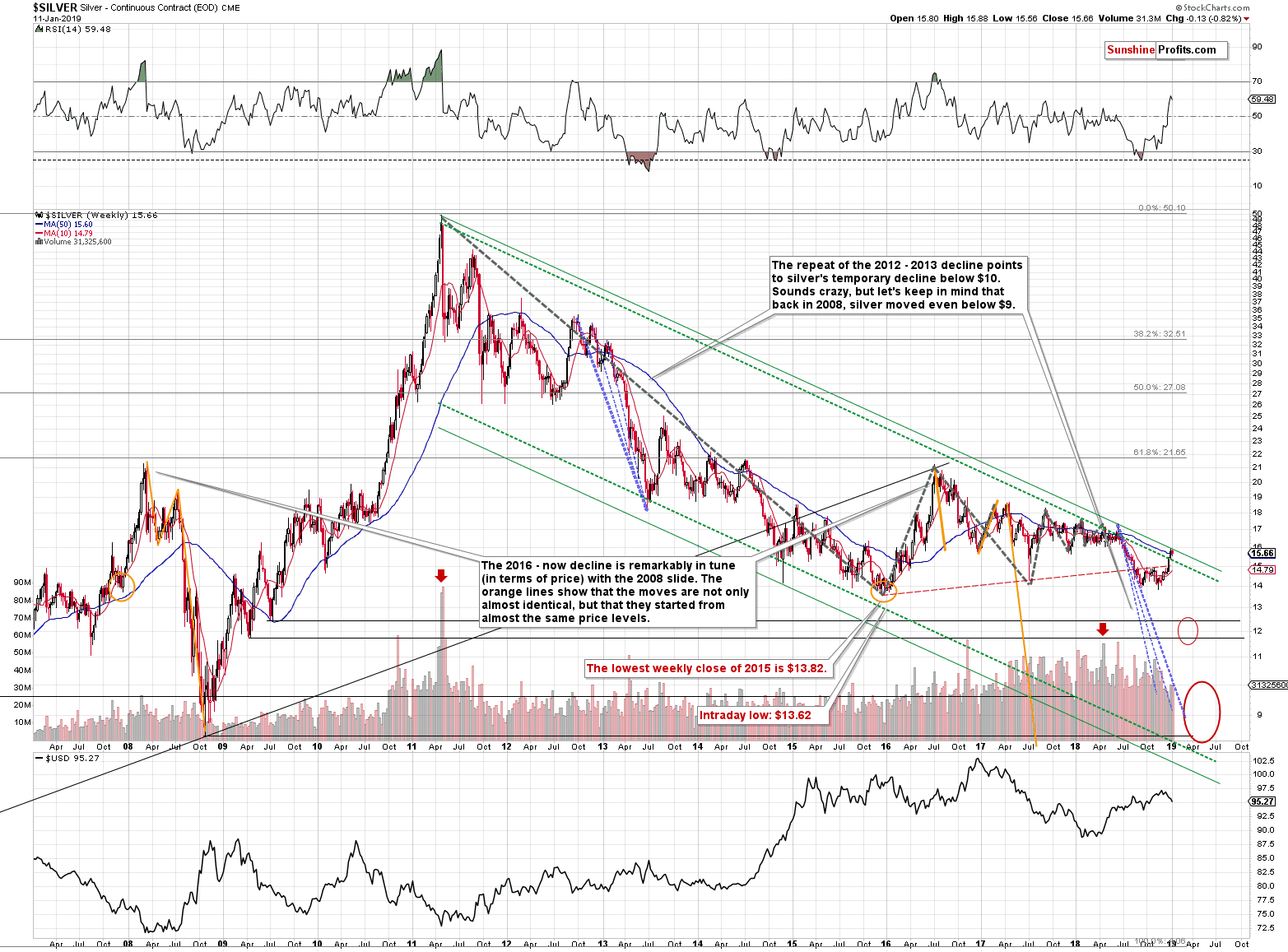
In case of silver, we have the same timing details as in gold, and we can say the same thing about the target prices as we did with regard to the yellow metal – they didn’t change. Silver is likely to break below its 2015 bottom when gold moves to its 2015 low, because of silver’s current medium-term underperformance. The final bottom for the white metal is likely to form close to its 2008 bottom, perhaps around $10, but it’s possible that silver would even move below $9 at the exact bottom. Such a move would most likely be very brief, just like it was in 2018. Let’s keep in mind that it took silver less than 3 years to then rally from below $9 to about $50 and we can expect similar kind of strength (or even greater) after the final bottom.
Earlier today, we wrote about the analogy between now and 2008 – it’s visible on the above chart and marked with orange lines. There’s no analogy in time or shape, but there is an extremely clear analogy in terms of the price. Starting with the orange ellipses (late 2007 and late 2015), the price moves marked with orange lines are practically identical. The only one that’s left to complete the pattern is the decline to the 2008 bottom or relatively close to it. Based on the $890 target in gold and the 100 target for the gold to silver ratio, this level is quite possible. Yes, it sounds crazy, but let’s keep in mind that in 2008, silver declined below $9 starting from above $19. And if something even crazier already happened, then such a move this year is definitely not out of the question.
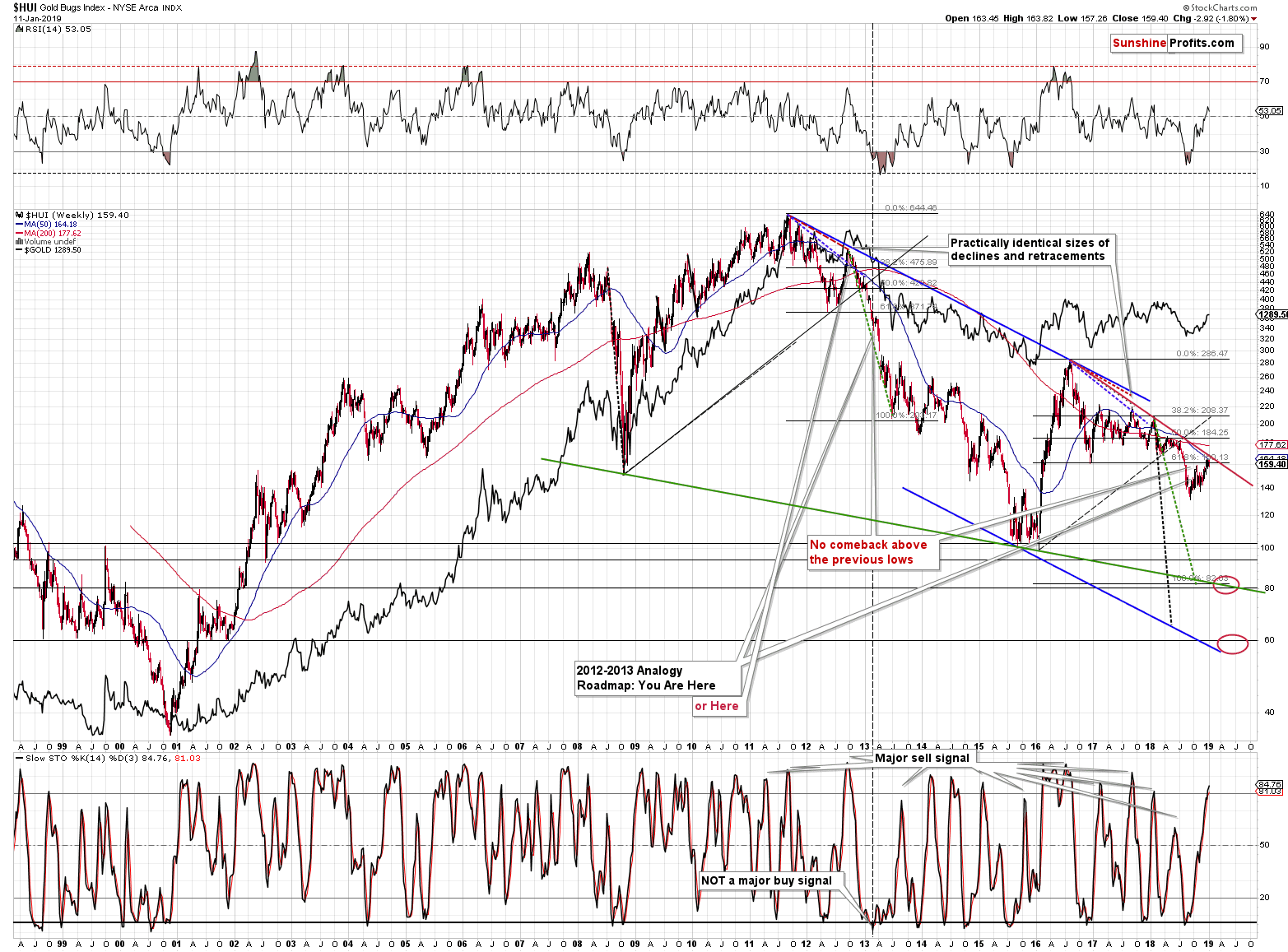
In case of the gold stocks, we once again have the same targets in terms of time, and – like in silver – we have unchanged targets in terms of prices.
The proximity of the 80 level is a target area that’s based on several techniques – the previous extremes (1999 top, 2000 top, 2001 top, early 2002 bottom), the Fibonacci extension based on the 2016 move lower (this technique worked particularly well during the 2013 decline) and the long-term support line based on the 2008 and 2016 bottoms). The green, dashed line also confirms the 80 level as the likely target based on the analogy to the size of the decline from the most recent notable local high (as during the 2012 – 2013 decline).
There is also a lower target at about 60 which is based on the declining support line and the previous bottoms. This target is not as likely as the 80 as less techniques point to it, but it’s still something worth keeping in mind.
The targets for gold and silver are clearer than the ones for the mining stocks, so when gold moves to about $900, silver moves to $10 or below and the gold to silver ratio is close to 100, we will check which strong target is nearby in case of the mining stocks – this will most likely be THE target that we’ll be looking for.
By the way, the fact that mining stocks didn’t invalidate the breakdown below their late-2016 bottom is a very strong bearish indication for the medium-term (and a new medium-term bearish factor that we didn’t have 6 months ago). That was a major breakdown and since it’s been verified, the price is now very likely to move to the next major support -and there’s practically no strong support all the way down to the 2015 and 2016 bottoms.
Having said that, let’s briefly discuss the most recent price changes. Briefly, because gold and silver didn’t do much on Friday – they closed more or less where they had closed on Thursday. Consequently, we will focus on the USD Index and the gold stocks.
The Gold – USDX Link
In short, everything that we wrote about the USDX recently, remains up-to-date. It may still decline this week and reach the red target area, but it’s not likely to trigger a massive rally in precious metals and mining stocks. Quoting our previous analysis:
The USD Index had previously quickly invalidated its breakdown below the rising blue support line, but this wasn’t the case in the last few days. This time, the breakdown below the rising blue support line was just confirmed, which is a bearish sign for the very short term.
We marked the possible downside target for the USD Index, while at the same time keeping the big upside target as well. The rally after the final bottom could be sharp, so both targets could be reached.
The downside target is approximately between 94 and 94.5. That’s about 1 – 1.5 index point decline from the current levels. This approximately means doubling the decline from this year’s top (January 2nd) to the current level. This may seem like a big deal for the precious metals investors, but actually it isn’t one.
The reason is the weakening in the strength of reaction to USD’s bearish signals that we recently discussed by examining gold’s performance in terms of the euro. Gold and silver simply refuse to rally on lower USDX as their respective resistance levels were already reached. On January 2nd, gold closed at $1,284 while silver closed at $15.65. That’s more or less where both metals are right now. Consequently, the repeat of the Jan 2nd – today performance wouldn’t mean practically anything for the PMs.
In other words, while the USD Index may decline in the next several days, the precious metals sector is not likely to rally in a meaningful way based on it. However, if the USD Index moves higher (and the yen declines in value), gold and silver will likely plunge. The above (just the above, without taking other factors into account)appears to have only mildly bearish implications for gold and silver, but at the same time it’s definitely justified to keep the short positions intact. This may seem surprising, but it is really the case.
While probability of small upswing and big declines in the next few days may be similar for the PMs (thus implications may appear neutral or close to neutral), the likely size of the moves are not. The upside potential for the PMs appears very limited, while the downside potential is huge. Moreover, adding more factors to this picture – the ones that we described previously – makes the current short position definitely justified from the risk to reward point of view.
The above remains up-to-date. The USDX moved to 94.64 yesterday, which is close to the target area that we mentioned yesterday (94 – 94.5), but not yet in it. Consequently, we may see a bit more weakness in the following hours and – perhaps – days. The key thing is that the lower border of the target area will be reached if yesterday’s decline is simply doubled (approximately).
Gold Stocks’ First Breakdown
In the previous Alert, we wrote the following about the situation in the HUI Index:
Gold stocks broke below the rising green support line that’s based on the most recent lows. The line is based on 3 lows (last one in late December), which means that it already worked once. It was also where miners closed on Tuesday after the intraday reversal. This line was finally broken yesterday. The breakdown is not yet confirmed, so it’s not yet a very bearish sign, but it seems to be a good sign that the very short-term dynamic has changed. We have ton of medium-, and long-term signs pointing to much lower PM prices, so a very short-term sign suggesting that the waiting may be over is a good addition.
Still, since gold and silver moved higher in today’s overnight trading, it wouldn’t be surprising to see miners move to this green line (to about 162.5) and verify the breakdown.
The above remains mostly up-to-date. The change is that we now have two daily closes and one weekly close below the rising green support line, which makes the breakdown almost confirmed. If the USDX declines and gold and silver respond with a temporary upswing, it would not be surprising to see a corrective upswing back to the green line at about 162.5. Naturally, this is not inevitable. We might see this decline’s continuation right away.
Summary
Summing up, even though the link between 2013 and now in case of gold is no longer clear, it doesn’t mean that the outlook changed. It was only one of the medium-term factors pointing to much lower gold, silver, and mining stock values in the following months, and the remaining factors (plus a few new ones) continue to justify the very bearish outlook. This means that there is a very high probability of a huge downswing and this is what makes the short position justified, not the outlook for the next few days. The bearish outlook for the following weeks is confirmed by multiple factors, i.a. silver’s extreme outperformance and miners’ underperformance, gold’s performance link with the general stock market, gold getting Cramerized, and the bullish medium-term outlook for the USD Index and bearish outlook for the key part thereof – the Japanese yen. Even if the USD Index moves lower in the next several days, it shouldn’t have a major impact on the prices of PMs.
While being patient in order to maximize the chance of making the most of the upcoming decline seems to be the best approach in our view, we realize that this may not be the preferred approach for everyone. Consequently, we are working on providing you with an additional service that will focus on the very short-term moves and frequent (much smaller than the ones on the big moves, but on the other hand likely more consistent) profits. We don’t want to provide a specific launch date for this service, as a lot “depends”, but it’s likely that we’ll introduce it sometime in February or March. We would appreciate your feedback on this idea – your suggestions will help us shape this upcoming service in the form that’s most useful to you.
As always, we’ll keep you – our subscribers – informed.
To summarize:
Trading capital (supplementary part of the portfolio; our opinion): Full short positions (250% of the full position) in gold, silver and mining stocks are justified from the risk/reward perspective with the following stop-loss orders and exit profit-take price levels:
- Gold: profit-take exit price: $1,062; stop-loss: $1,313; initial target price for the DGLD ETN: $82.96; stop-loss for the DGLD ETN $44.97
- Silver: profit-take exit price: $12.32; stop-loss: $16.04; initial target price for the DSLV ETN: $47.67; stop-loss for the DSLV ETN $24.68
- Mining stocks (price levels for the GDX ETF): profit-take exit price: $13.12; stop-loss: $22.03; initial target price for the DUST ETF: $80.97; stop-loss for the DUST ETF $20.37
Note: the above is a specific preparation for a possible sudden price drop, it does not reflect the most likely outcome. You will find a more detailed explanation in our August 1st Alert. In case one wants to bet on junior mining stocks’ prices (we do not suggest doing so – we think senior mining stocks are more predictable in the case of short-term trades – if one wants to do it anyway, we provide the details), here are the stop-loss details and target prices:
- GDXJ ETF: profit-take exit price: $17.52; stop-loss: $32.03
- JDST ETF: initial target price: $154.97 stop-loss: $42.17
Long-term capital (core part of the portfolio; our opinion): No positions (in other words: cash)
Insurance capital (core part of the portfolio; our opinion): Full position
Important Details for New Subscribers
Whether you already subscribed or not, we encourage you to find out how to make the most of our alerts and read our replies to the most common alert-and-gold-trading-related-questions.
Please note that the in the trading section we describe the situation for the day that the alert is posted. In other words, it we are writing about a speculative position, it means that it is up-to-date on the day it was posted. We are also featuring the initial target prices, so that you can decide whether keeping a position on a given day is something that is in tune with your approach (some moves are too small for medium-term traders and some might appear too big for day-traders).
Plus, you might want to read why our stop-loss orders are usually relatively far from the current price.
Please note that a full position doesn’t mean using all of the capital for a given trade. You will find details on our thoughts on gold portfolio structuring in the Key Insights section on our website.
As a reminder – “initial target price” means exactly that – an “initial” one, it’s not a price level at which we suggest closing positions. If this becomes the case (like it did in the previous trade) we will refer to these levels as levels of exit orders (exactly as we’ve done previously). Stop-loss levels, however, are naturally not “initial”, but something that, in our opinion, might be entered as an order.
Since it is impossible to synchronize target prices and stop-loss levels for all the ETFs and ETNs with the main markets that we provide these levels for (gold, silver and mining stocks – the GDX ETF), the stop-loss levels and target prices for other ETNs and ETF (among other: UGLD, DGLD, USLV, DSLV, NUGT, DUST, JNUG, JDST) are provided as supplementary, and not as “final”. This means that if a stop-loss or a target level is reached for any of the “additional instruments” (DGLD for instance), but not for the “main instrument” (gold in this case), we will view positions in both gold and DGLD as still open and the stop-loss for DGLD would have to be moved lower. On the other hand, if gold moves to a stop-loss level but DGLD doesn’t, then we will view both positions (in gold and DGLD) as closed. In other words, since it’s not possible to be 100% certain that each related instrument moves to a given level when the underlying instrument does, we can’t provide levels that would be binding. The levels that we do provide are our best estimate of the levels that will correspond to the levels in the underlying assets, but it will be the underlying assets that one will need to focus on regarding the signs pointing to closing a given position or keeping it open. We might adjust the levels in the “additional instruments” without adjusting the levels in the “main instruments”, which will simply mean that we have improved our estimation of these levels, not that we changed our outlook on the markets. We are already working on a tool that would update these levels on a daily basis for the most popular ETFs, ETNs and individual mining stocks.
Our preferred ways to invest in and to trade gold along with the reasoning can be found in the how to buy gold section. Additionally, our preferred ETFs and ETNs can be found in our Gold & Silver ETF Ranking.
As a reminder, Gold & Silver Trading Alerts are posted before or on each trading day (we usually post them before the opening bell, but we don't promise doing that each day). If there's anything urgent, we will send you an additional small alert before posting the main one.
=====
Latest Free Trading Alerts:
Stocks were little changed on Friday, as investors hesitated following the recent rally. The broad stock market has retraced its recent decline following the S&P 500's breakdown below 2,600. Will the short-term uptrend continue? Or is this still just an upward correction before another leg lower?
S&P 500 Bounces Off 2,600, Downward Reversal?
=====
Thank you.
Sincerely,
Przemyslaw Radomski, CFA
Editor-in-chief, Gold & Silver Fund Manager


